Exogenous Cushing's Syndrome Case Study: NRSG353 Assignment
VerifiedAdded on 2023/04/17
|10
|1939
|333
Case Study
AI Summary
This case study focuses on Exogenous Cushing's Syndrome (ECS), examining the disease, its causes, incidence, and risk factors. It delves into the impact of ECS on the patient and their family, followed by a discussion of common signs and symptoms, including their underlying pathophysiology. The assignment also analyzes the pharmacodynamics and pharmacokinetics of statins, a relevant drug class for managing related conditions like high cholesterol, and concludes with a nursing care plan for the patient. The case study incorporates relevant medical literature and provides a comprehensive overview of ECS management.

Running Head: ECS
0
ECS
student
3/26/2019
0
ECS
student
3/26/2019
Paraphrase This Document
Need a fresh take? Get an instant paraphrase of this document with our AI Paraphraser
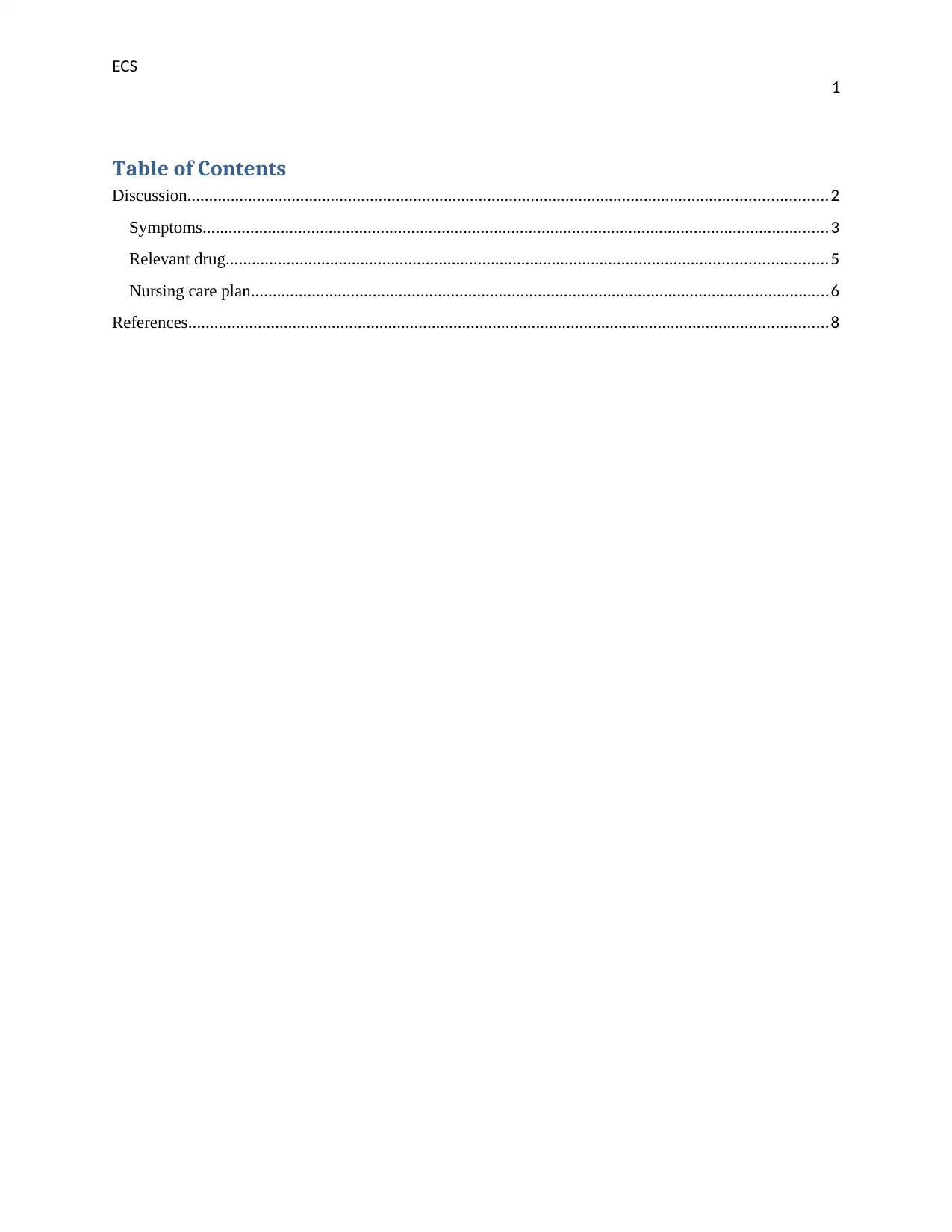
ECS
1
Table of Contents
Discussion...................................................................................................................................................2
Symptoms................................................................................................................................................3
Relevant drug..........................................................................................................................................5
Nursing care plan.....................................................................................................................................6
References...................................................................................................................................................8
1
Table of Contents
Discussion...................................................................................................................................................2
Symptoms................................................................................................................................................3
Relevant drug..........................................................................................................................................5
Nursing care plan.....................................................................................................................................6
References...................................................................................................................................................8
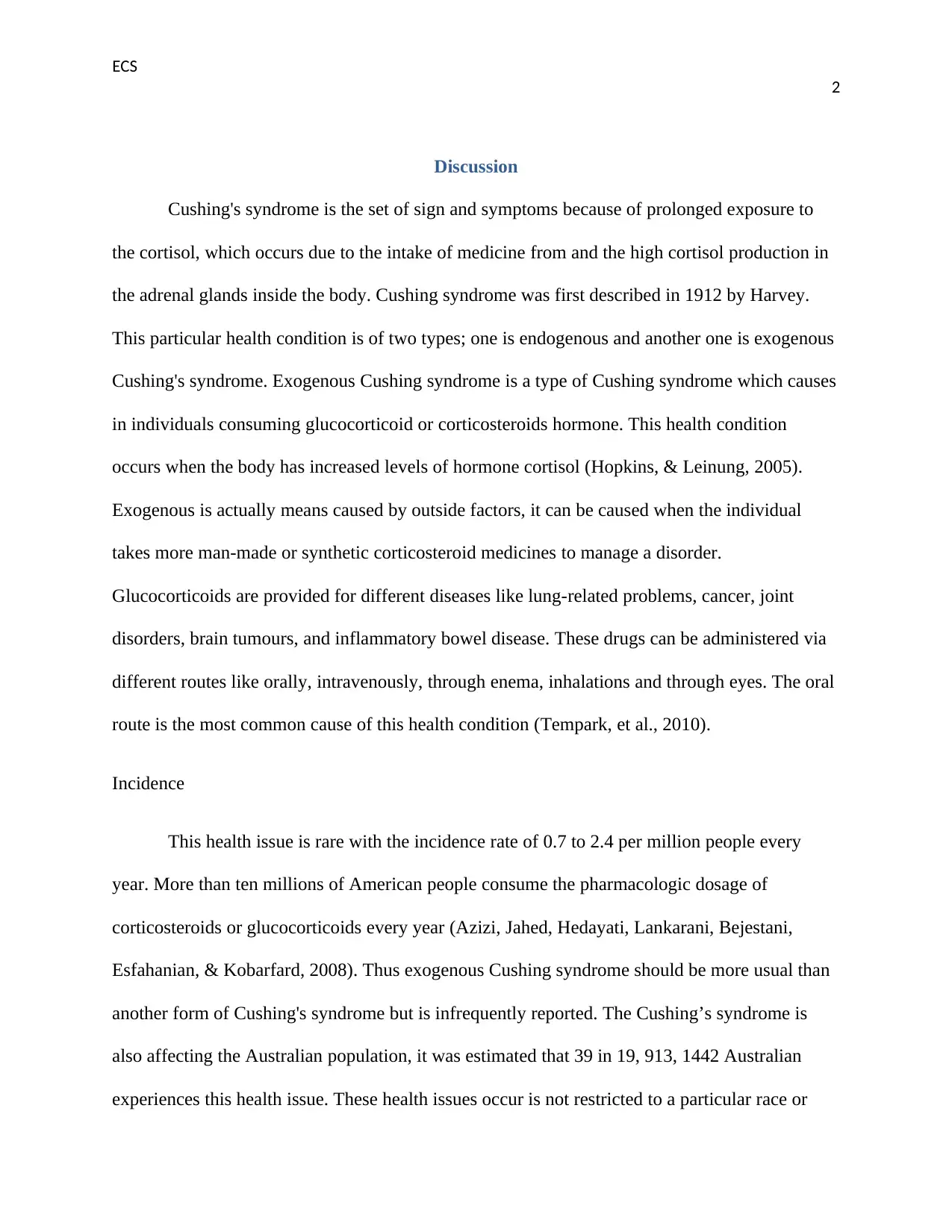
ECS
2
Discussion
Cushing's syndrome is the set of sign and symptoms because of prolonged exposure to
the cortisol, which occurs due to the intake of medicine from and the high cortisol production in
the adrenal glands inside the body. Cushing syndrome was first described in 1912 by Harvey.
This particular health condition is of two types; one is endogenous and another one is exogenous
Cushing's syndrome. Exogenous Cushing syndrome is a type of Cushing syndrome which causes
in individuals consuming glucocorticoid or corticosteroids hormone. This health condition
occurs when the body has increased levels of hormone cortisol (Hopkins, & Leinung, 2005).
Exogenous is actually means caused by outside factors, it can be caused when the individual
takes more man-made or synthetic corticosteroid medicines to manage a disorder.
Glucocorticoids are provided for different diseases like lung-related problems, cancer, joint
disorders, brain tumours, and inflammatory bowel disease. These drugs can be administered via
different routes like orally, intravenously, through enema, inhalations and through eyes. The oral
route is the most common cause of this health condition (Tempark, et al., 2010).
Incidence
This health issue is rare with the incidence rate of 0.7 to 2.4 per million people every
year. More than ten millions of American people consume the pharmacologic dosage of
corticosteroids or glucocorticoids every year (Azizi, Jahed, Hedayati, Lankarani, Bejestani,
Esfahanian, & Kobarfard, 2008). Thus exogenous Cushing syndrome should be more usual than
another form of Cushing's syndrome but is infrequently reported. The Cushing’s syndrome is
also affecting the Australian population, it was estimated that 39 in 19, 913, 1442 Australian
experiences this health issue. These health issues occur is not restricted to a particular race or
2
Discussion
Cushing's syndrome is the set of sign and symptoms because of prolonged exposure to
the cortisol, which occurs due to the intake of medicine from and the high cortisol production in
the adrenal glands inside the body. Cushing syndrome was first described in 1912 by Harvey.
This particular health condition is of two types; one is endogenous and another one is exogenous
Cushing's syndrome. Exogenous Cushing syndrome is a type of Cushing syndrome which causes
in individuals consuming glucocorticoid or corticosteroids hormone. This health condition
occurs when the body has increased levels of hormone cortisol (Hopkins, & Leinung, 2005).
Exogenous is actually means caused by outside factors, it can be caused when the individual
takes more man-made or synthetic corticosteroid medicines to manage a disorder.
Glucocorticoids are provided for different diseases like lung-related problems, cancer, joint
disorders, brain tumours, and inflammatory bowel disease. These drugs can be administered via
different routes like orally, intravenously, through enema, inhalations and through eyes. The oral
route is the most common cause of this health condition (Tempark, et al., 2010).
Incidence
This health issue is rare with the incidence rate of 0.7 to 2.4 per million people every
year. More than ten millions of American people consume the pharmacologic dosage of
corticosteroids or glucocorticoids every year (Azizi, Jahed, Hedayati, Lankarani, Bejestani,
Esfahanian, & Kobarfard, 2008). Thus exogenous Cushing syndrome should be more usual than
another form of Cushing's syndrome but is infrequently reported. The Cushing’s syndrome is
also affecting the Australian population, it was estimated that 39 in 19, 913, 1442 Australian
experiences this health issue. These health issues occur is not restricted to a particular race or
⊘ This is a preview!⊘
Do you want full access?
Subscribe today to unlock all pages.

Trusted by 1+ million students worldwide
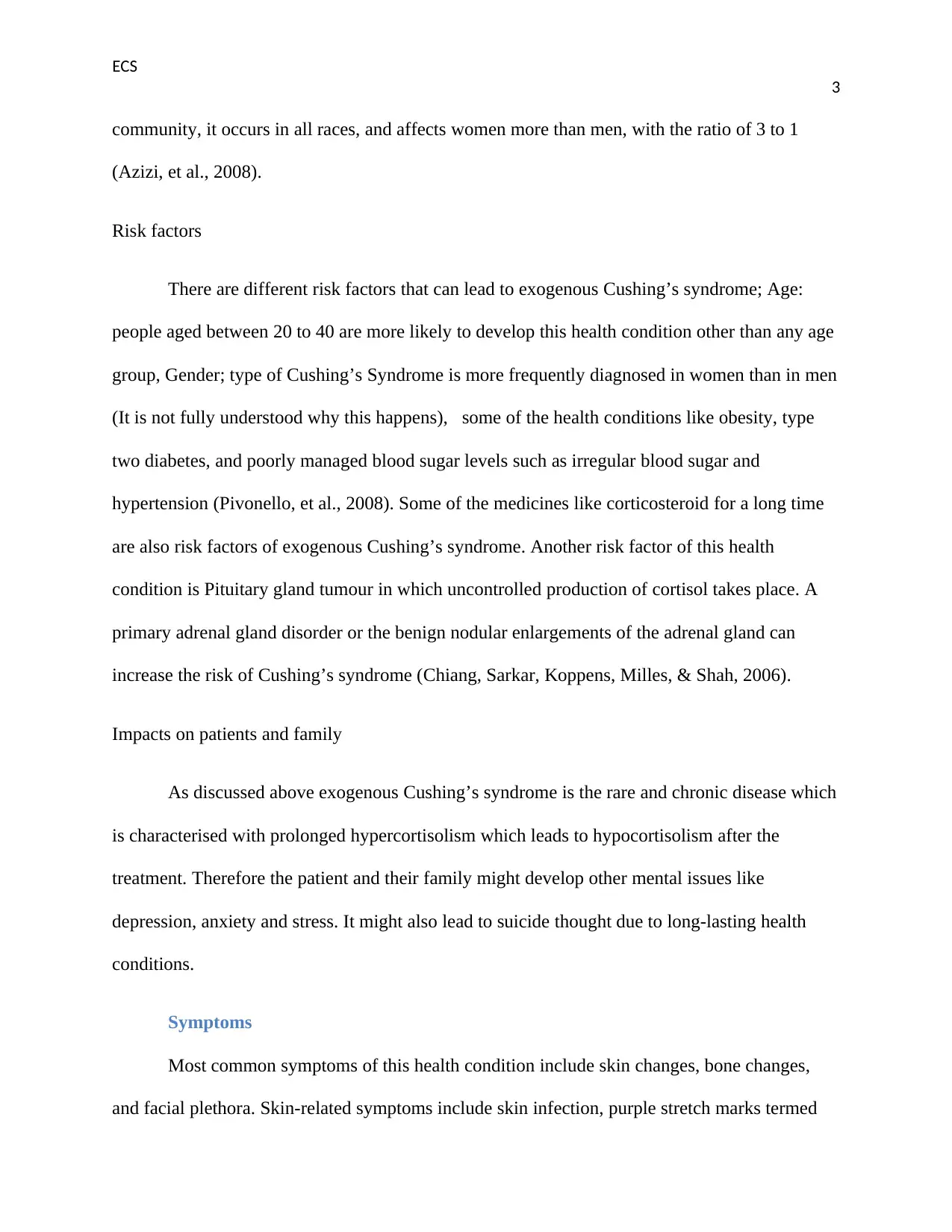
ECS
3
community, it occurs in all races, and affects women more than men, with the ratio of 3 to 1
(Azizi, et al., 2008).
Risk factors
There are different risk factors that can lead to exogenous Cushing’s syndrome; Age:
people aged between 20 to 40 are more likely to develop this health condition other than any age
group, Gender; type of Cushing’s Syndrome is more frequently diagnosed in women than in men
(It is not fully understood why this happens), some of the health conditions like obesity, type
two diabetes, and poorly managed blood sugar levels such as irregular blood sugar and
hypertension (Pivonello, et al., 2008). Some of the medicines like corticosteroid for a long time
are also risk factors of exogenous Cushing’s syndrome. Another risk factor of this health
condition is Pituitary gland tumour in which uncontrolled production of cortisol takes place. A
primary adrenal gland disorder or the benign nodular enlargements of the adrenal gland can
increase the risk of Cushing’s syndrome (Chiang, Sarkar, Koppens, Milles, & Shah, 2006).
Impacts on patients and family
As discussed above exogenous Cushing’s syndrome is the rare and chronic disease which
is characterised with prolonged hypercortisolism which leads to hypocortisolism after the
treatment. Therefore the patient and their family might develop other mental issues like
depression, anxiety and stress. It might also lead to suicide thought due to long-lasting health
conditions.
Symptoms
Most common symptoms of this health condition include skin changes, bone changes,
and facial plethora. Skin-related symptoms include skin infection, purple stretch marks termed
3
community, it occurs in all races, and affects women more than men, with the ratio of 3 to 1
(Azizi, et al., 2008).
Risk factors
There are different risk factors that can lead to exogenous Cushing’s syndrome; Age:
people aged between 20 to 40 are more likely to develop this health condition other than any age
group, Gender; type of Cushing’s Syndrome is more frequently diagnosed in women than in men
(It is not fully understood why this happens), some of the health conditions like obesity, type
two diabetes, and poorly managed blood sugar levels such as irregular blood sugar and
hypertension (Pivonello, et al., 2008). Some of the medicines like corticosteroid for a long time
are also risk factors of exogenous Cushing’s syndrome. Another risk factor of this health
condition is Pituitary gland tumour in which uncontrolled production of cortisol takes place. A
primary adrenal gland disorder or the benign nodular enlargements of the adrenal gland can
increase the risk of Cushing’s syndrome (Chiang, Sarkar, Koppens, Milles, & Shah, 2006).
Impacts on patients and family
As discussed above exogenous Cushing’s syndrome is the rare and chronic disease which
is characterised with prolonged hypercortisolism which leads to hypocortisolism after the
treatment. Therefore the patient and their family might develop other mental issues like
depression, anxiety and stress. It might also lead to suicide thought due to long-lasting health
conditions.
Symptoms
Most common symptoms of this health condition include skin changes, bone changes,
and facial plethora. Skin-related symptoms include skin infection, purple stretch marks termed
Paraphrase This Document
Need a fresh take? Get an instant paraphrase of this document with our AI Paraphraser
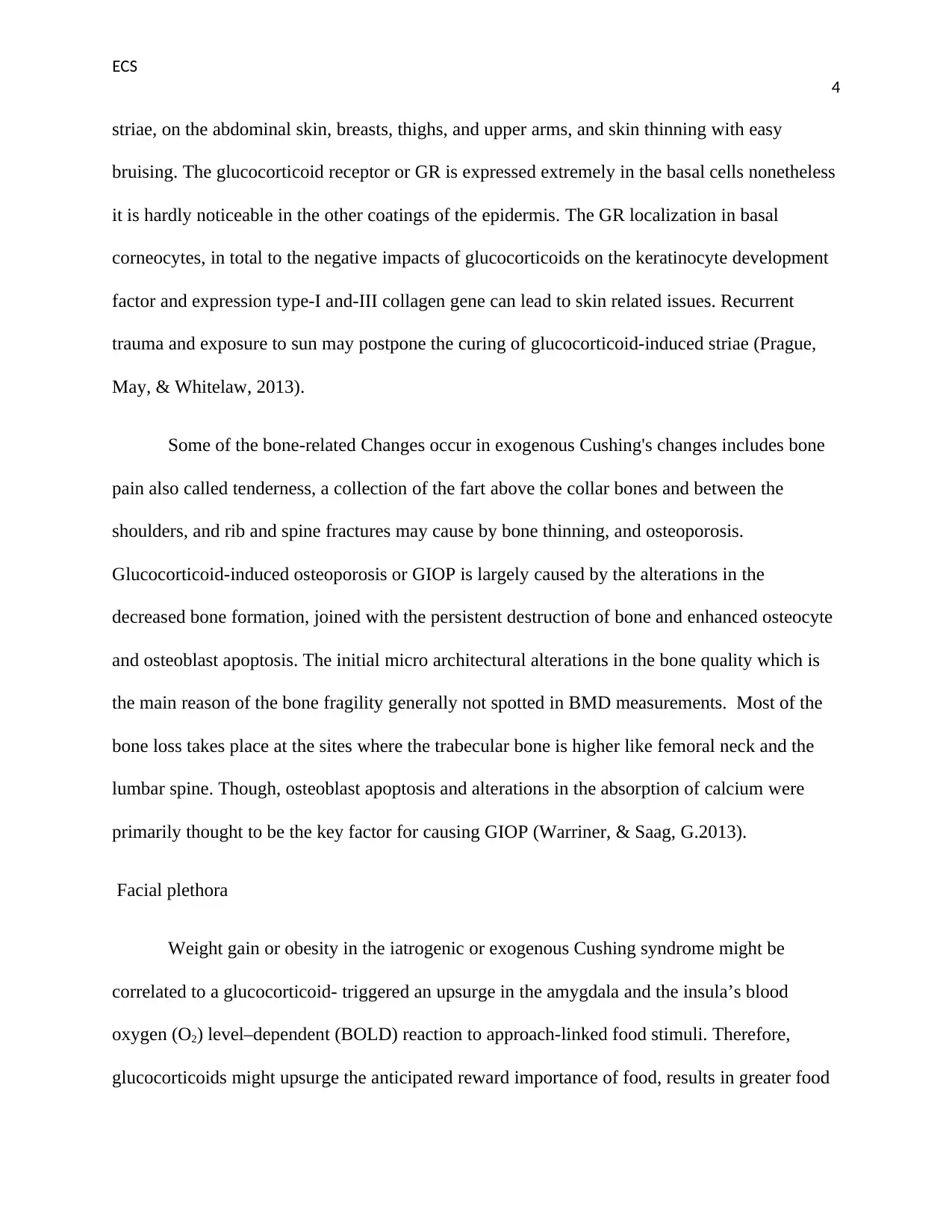
ECS
4
striae, on the abdominal skin, breasts, thighs, and upper arms, and skin thinning with easy
bruising. The glucocorticoid receptor or GR is expressed extremely in the basal cells nonetheless
it is hardly noticeable in the other coatings of the epidermis. The GR localization in basal
corneocytes, in total to the negative impacts of glucocorticoids on the keratinocyte development
factor and expression type-I and-III collagen gene can lead to skin related issues. Recurrent
trauma and exposure to sun may postpone the curing of glucocorticoid-induced striae (Prague,
May, & Whitelaw, 2013).
Some of the bone-related Changes occur in exogenous Cushing's changes includes bone
pain also called tenderness, a collection of the fart above the collar bones and between the
shoulders, and rib and spine fractures may cause by bone thinning, and osteoporosis.
Glucocorticoid-induced osteoporosis or GIOP is largely caused by the alterations in the
decreased bone formation, joined with the persistent destruction of bone and enhanced osteocyte
and osteoblast apoptosis. The initial micro architectural alterations in the bone quality which is
the main reason of the bone fragility generally not spotted in BMD measurements. Most of the
bone loss takes place at the sites where the trabecular bone is higher like femoral neck and the
lumbar spine. Though, osteoblast apoptosis and alterations in the absorption of calcium were
primarily thought to be the key factor for causing GIOP (Warriner, & Saag, G.2013).
Facial plethora
Weight gain or obesity in the iatrogenic or exogenous Cushing syndrome might be
correlated to a glucocorticoid- triggered an upsurge in the amygdala and the insula’s blood
oxygen (O2) level–dependent (BOLD) reaction to approach-linked food stimuli. Therefore,
glucocorticoids might upsurge the anticipated reward importance of food, results in greater food
4
striae, on the abdominal skin, breasts, thighs, and upper arms, and skin thinning with easy
bruising. The glucocorticoid receptor or GR is expressed extremely in the basal cells nonetheless
it is hardly noticeable in the other coatings of the epidermis. The GR localization in basal
corneocytes, in total to the negative impacts of glucocorticoids on the keratinocyte development
factor and expression type-I and-III collagen gene can lead to skin related issues. Recurrent
trauma and exposure to sun may postpone the curing of glucocorticoid-induced striae (Prague,
May, & Whitelaw, 2013).
Some of the bone-related Changes occur in exogenous Cushing's changes includes bone
pain also called tenderness, a collection of the fart above the collar bones and between the
shoulders, and rib and spine fractures may cause by bone thinning, and osteoporosis.
Glucocorticoid-induced osteoporosis or GIOP is largely caused by the alterations in the
decreased bone formation, joined with the persistent destruction of bone and enhanced osteocyte
and osteoblast apoptosis. The initial micro architectural alterations in the bone quality which is
the main reason of the bone fragility generally not spotted in BMD measurements. Most of the
bone loss takes place at the sites where the trabecular bone is higher like femoral neck and the
lumbar spine. Though, osteoblast apoptosis and alterations in the absorption of calcium were
primarily thought to be the key factor for causing GIOP (Warriner, & Saag, G.2013).
Facial plethora
Weight gain or obesity in the iatrogenic or exogenous Cushing syndrome might be
correlated to a glucocorticoid- triggered an upsurge in the amygdala and the insula’s blood
oxygen (O2) level–dependent (BOLD) reaction to approach-linked food stimuli. Therefore,
glucocorticoids might upsurge the anticipated reward importance of food, results in greater food
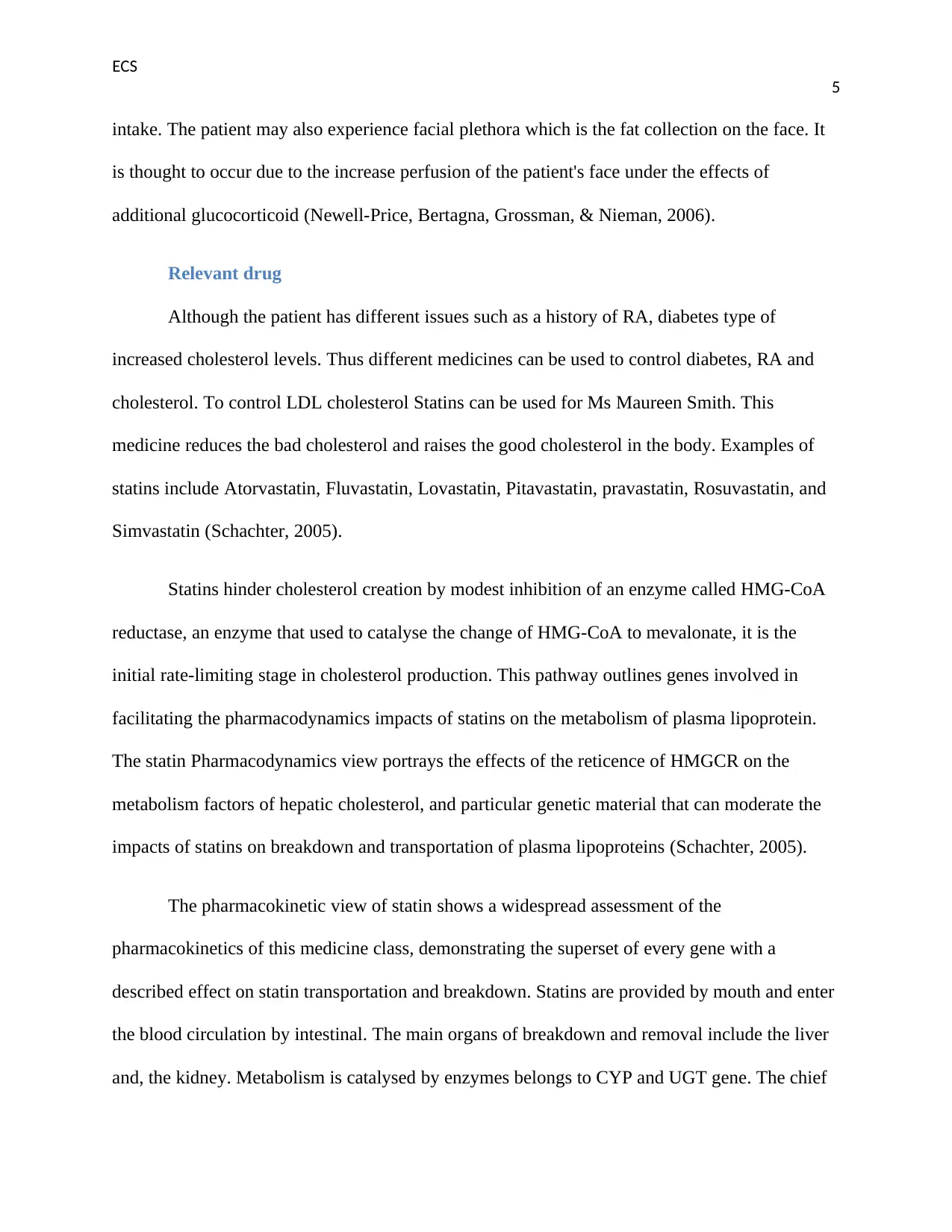
ECS
5
intake. The patient may also experience facial plethora which is the fat collection on the face. It
is thought to occur due to the increase perfusion of the patient's face under the effects of
additional glucocorticoid (Newell-Price, Bertagna, Grossman, & Nieman, 2006).
Relevant drug
Although the patient has different issues such as a history of RA, diabetes type of
increased cholesterol levels. Thus different medicines can be used to control diabetes, RA and
cholesterol. To control LDL cholesterol Statins can be used for Ms Maureen Smith. This
medicine reduces the bad cholesterol and raises the good cholesterol in the body. Examples of
statins include Atorvastatin, Fluvastatin, Lovastatin, Pitavastatin, pravastatin, Rosuvastatin, and
Simvastatin (Schachter, 2005).
Statins hinder cholesterol creation by modest inhibition of an enzyme called HMG-CoA
reductase, an enzyme that used to catalyse the change of HMG-CoA to mevalonate, it is the
initial rate-limiting stage in cholesterol production. This pathway outlines genes involved in
facilitating the pharmacodynamics impacts of statins on the metabolism of plasma lipoprotein.
The statin Pharmacodynamics view portrays the effects of the reticence of HMGCR on the
metabolism factors of hepatic cholesterol, and particular genetic material that can moderate the
impacts of statins on breakdown and transportation of plasma lipoproteins (Schachter, 2005).
The pharmacokinetic view of statin shows a widespread assessment of the
pharmacokinetics of this medicine class, demonstrating the superset of every gene with a
described effect on statin transportation and breakdown. Statins are provided by mouth and enter
the blood circulation by intestinal. The main organs of breakdown and removal include the liver
and, the kidney. Metabolism is catalysed by enzymes belongs to CYP and UGT gene. The chief
5
intake. The patient may also experience facial plethora which is the fat collection on the face. It
is thought to occur due to the increase perfusion of the patient's face under the effects of
additional glucocorticoid (Newell-Price, Bertagna, Grossman, & Nieman, 2006).
Relevant drug
Although the patient has different issues such as a history of RA, diabetes type of
increased cholesterol levels. Thus different medicines can be used to control diabetes, RA and
cholesterol. To control LDL cholesterol Statins can be used for Ms Maureen Smith. This
medicine reduces the bad cholesterol and raises the good cholesterol in the body. Examples of
statins include Atorvastatin, Fluvastatin, Lovastatin, Pitavastatin, pravastatin, Rosuvastatin, and
Simvastatin (Schachter, 2005).
Statins hinder cholesterol creation by modest inhibition of an enzyme called HMG-CoA
reductase, an enzyme that used to catalyse the change of HMG-CoA to mevalonate, it is the
initial rate-limiting stage in cholesterol production. This pathway outlines genes involved in
facilitating the pharmacodynamics impacts of statins on the metabolism of plasma lipoprotein.
The statin Pharmacodynamics view portrays the effects of the reticence of HMGCR on the
metabolism factors of hepatic cholesterol, and particular genetic material that can moderate the
impacts of statins on breakdown and transportation of plasma lipoproteins (Schachter, 2005).
The pharmacokinetic view of statin shows a widespread assessment of the
pharmacokinetics of this medicine class, demonstrating the superset of every gene with a
described effect on statin transportation and breakdown. Statins are provided by mouth and enter
the blood circulation by intestinal. The main organs of breakdown and removal include the liver
and, the kidney. Metabolism is catalysed by enzymes belongs to CYP and UGT gene. The chief
⊘ This is a preview!⊘
Do you want full access?
Subscribe today to unlock all pages.

Trusted by 1+ million students worldwide
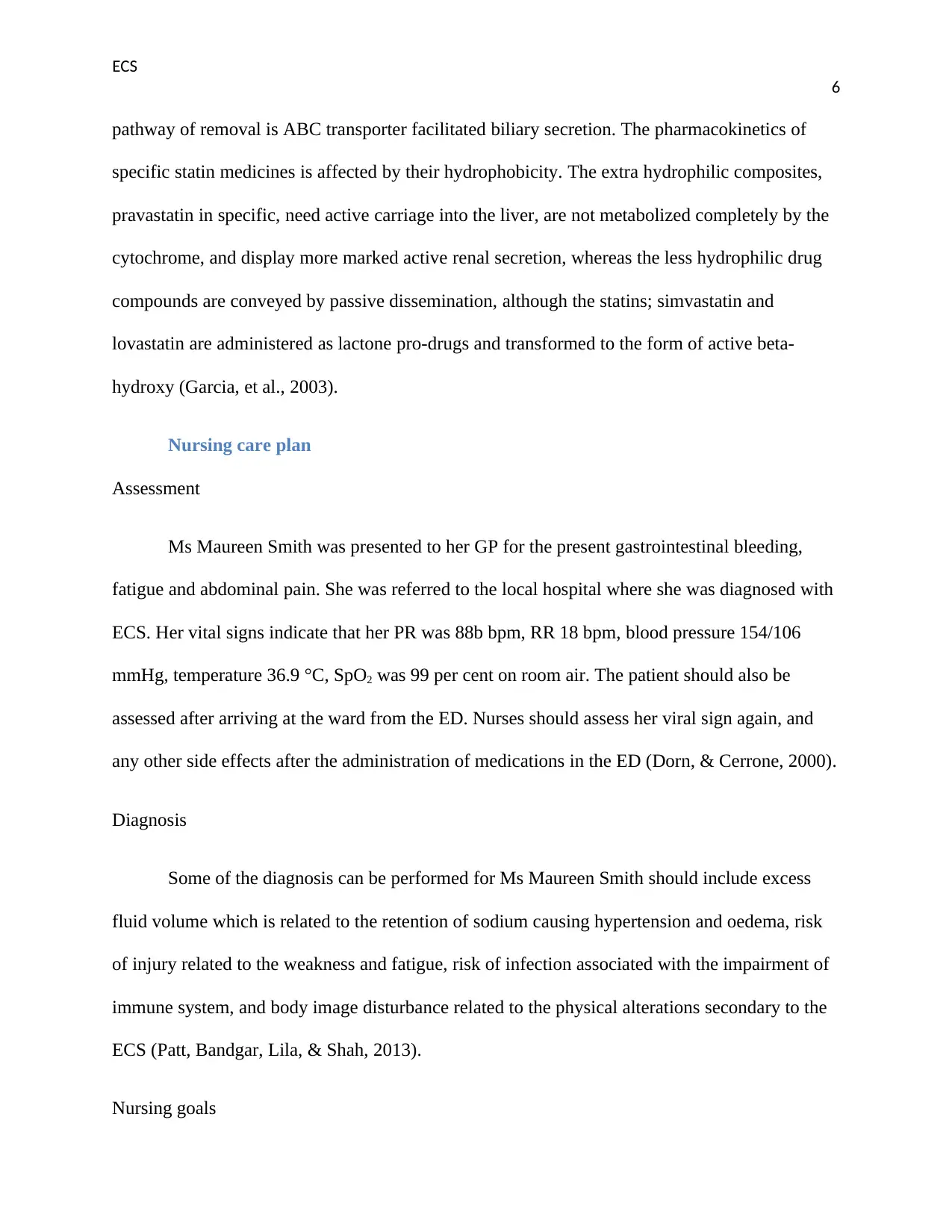
ECS
6
pathway of removal is ABC transporter facilitated biliary secretion. The pharmacokinetics of
specific statin medicines is affected by their hydrophobicity. The extra hydrophilic composites,
pravastatin in specific, need active carriage into the liver, are not metabolized completely by the
cytochrome, and display more marked active renal secretion, whereas the less hydrophilic drug
compounds are conveyed by passive dissemination, although the statins; simvastatin and
lovastatin are administered as lactone pro-drugs and transformed to the form of active beta-
hydroxy (Garcia, et al., 2003).
Nursing care plan
Assessment
Ms Maureen Smith was presented to her GP for the present gastrointestinal bleeding,
fatigue and abdominal pain. She was referred to the local hospital where she was diagnosed with
ECS. Her vital signs indicate that her PR was 88b bpm, RR 18 bpm, blood pressure 154/106
mmHg, temperature 36.9 °C, SpO2 was 99 per cent on room air. The patient should also be
assessed after arriving at the ward from the ED. Nurses should assess her viral sign again, and
any other side effects after the administration of medications in the ED (Dorn, & Cerrone, 2000).
Diagnosis
Some of the diagnosis can be performed for Ms Maureen Smith should include excess
fluid volume which is related to the retention of sodium causing hypertension and oedema, risk
of injury related to the weakness and fatigue, risk of infection associated with the impairment of
immune system, and body image disturbance related to the physical alterations secondary to the
ECS (Patt, Bandgar, Lila, & Shah, 2013).
Nursing goals
6
pathway of removal is ABC transporter facilitated biliary secretion. The pharmacokinetics of
specific statin medicines is affected by their hydrophobicity. The extra hydrophilic composites,
pravastatin in specific, need active carriage into the liver, are not metabolized completely by the
cytochrome, and display more marked active renal secretion, whereas the less hydrophilic drug
compounds are conveyed by passive dissemination, although the statins; simvastatin and
lovastatin are administered as lactone pro-drugs and transformed to the form of active beta-
hydroxy (Garcia, et al., 2003).
Nursing care plan
Assessment
Ms Maureen Smith was presented to her GP for the present gastrointestinal bleeding,
fatigue and abdominal pain. She was referred to the local hospital where she was diagnosed with
ECS. Her vital signs indicate that her PR was 88b bpm, RR 18 bpm, blood pressure 154/106
mmHg, temperature 36.9 °C, SpO2 was 99 per cent on room air. The patient should also be
assessed after arriving at the ward from the ED. Nurses should assess her viral sign again, and
any other side effects after the administration of medications in the ED (Dorn, & Cerrone, 2000).
Diagnosis
Some of the diagnosis can be performed for Ms Maureen Smith should include excess
fluid volume which is related to the retention of sodium causing hypertension and oedema, risk
of injury related to the weakness and fatigue, risk of infection associated with the impairment of
immune system, and body image disturbance related to the physical alterations secondary to the
ECS (Patt, Bandgar, Lila, & Shah, 2013).
Nursing goals
Paraphrase This Document
Need a fresh take? Get an instant paraphrase of this document with our AI Paraphraser
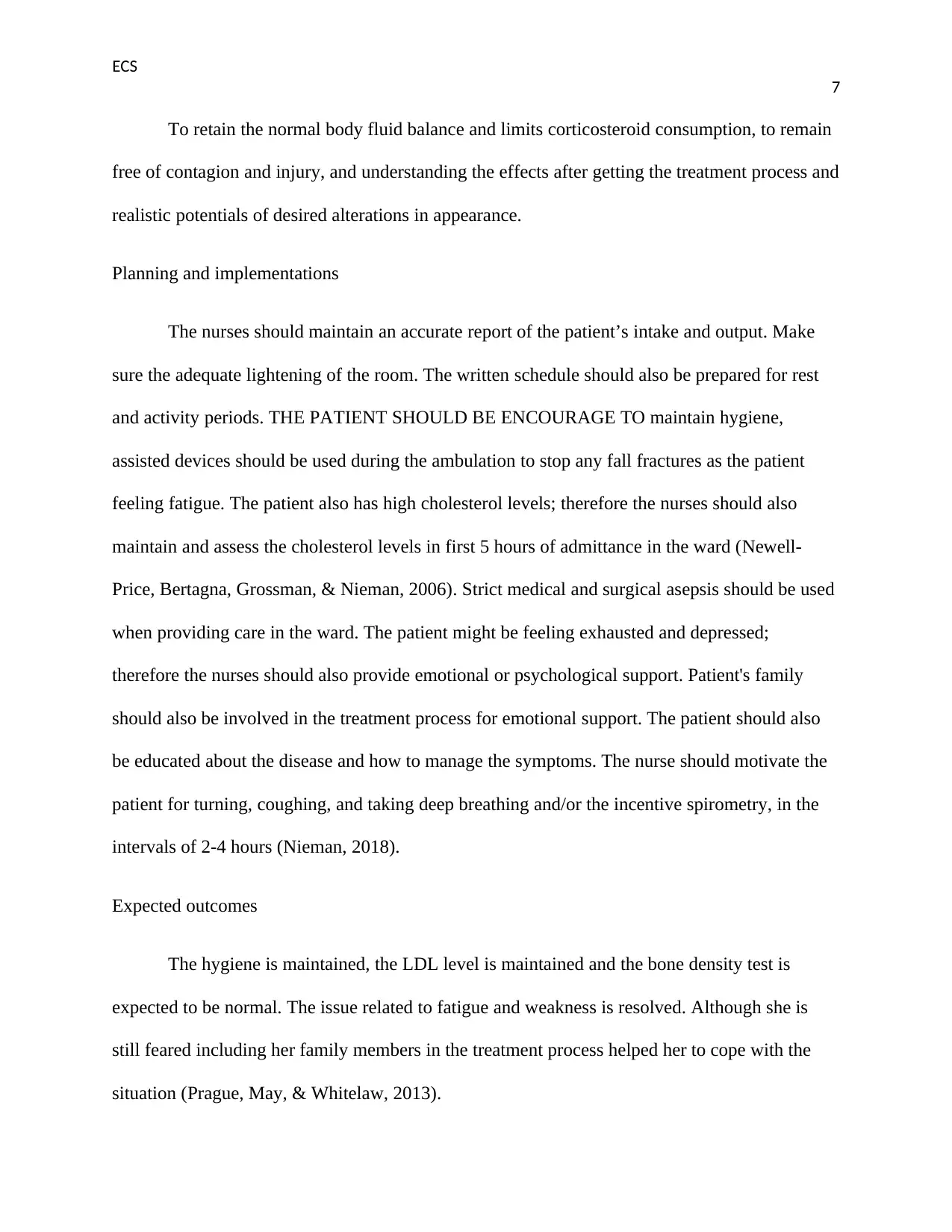
ECS
7
To retain the normal body fluid balance and limits corticosteroid consumption, to remain
free of contagion and injury, and understanding the effects after getting the treatment process and
realistic potentials of desired alterations in appearance.
Planning and implementations
The nurses should maintain an accurate report of the patient’s intake and output. Make
sure the adequate lightening of the room. The written schedule should also be prepared for rest
and activity periods. THE PATIENT SHOULD BE ENCOURAGE TO maintain hygiene,
assisted devices should be used during the ambulation to stop any fall fractures as the patient
feeling fatigue. The patient also has high cholesterol levels; therefore the nurses should also
maintain and assess the cholesterol levels in first 5 hours of admittance in the ward (Newell-
Price, Bertagna, Grossman, & Nieman, 2006). Strict medical and surgical asepsis should be used
when providing care in the ward. The patient might be feeling exhausted and depressed;
therefore the nurses should also provide emotional or psychological support. Patient's family
should also be involved in the treatment process for emotional support. The patient should also
be educated about the disease and how to manage the symptoms. The nurse should motivate the
patient for turning, coughing, and taking deep breathing and/or the incentive spirometry, in the
intervals of 2-4 hours (Nieman, 2018).
Expected outcomes
The hygiene is maintained, the LDL level is maintained and the bone density test is
expected to be normal. The issue related to fatigue and weakness is resolved. Although she is
still feared including her family members in the treatment process helped her to cope with the
situation (Prague, May, & Whitelaw, 2013).
7
To retain the normal body fluid balance and limits corticosteroid consumption, to remain
free of contagion and injury, and understanding the effects after getting the treatment process and
realistic potentials of desired alterations in appearance.
Planning and implementations
The nurses should maintain an accurate report of the patient’s intake and output. Make
sure the adequate lightening of the room. The written schedule should also be prepared for rest
and activity periods. THE PATIENT SHOULD BE ENCOURAGE TO maintain hygiene,
assisted devices should be used during the ambulation to stop any fall fractures as the patient
feeling fatigue. The patient also has high cholesterol levels; therefore the nurses should also
maintain and assess the cholesterol levels in first 5 hours of admittance in the ward (Newell-
Price, Bertagna, Grossman, & Nieman, 2006). Strict medical and surgical asepsis should be used
when providing care in the ward. The patient might be feeling exhausted and depressed;
therefore the nurses should also provide emotional or psychological support. Patient's family
should also be involved in the treatment process for emotional support. The patient should also
be educated about the disease and how to manage the symptoms. The nurse should motivate the
patient for turning, coughing, and taking deep breathing and/or the incentive spirometry, in the
intervals of 2-4 hours (Nieman, 2018).
Expected outcomes
The hygiene is maintained, the LDL level is maintained and the bone density test is
expected to be normal. The issue related to fatigue and weakness is resolved. Although she is
still feared including her family members in the treatment process helped her to cope with the
situation (Prague, May, & Whitelaw, 2013).
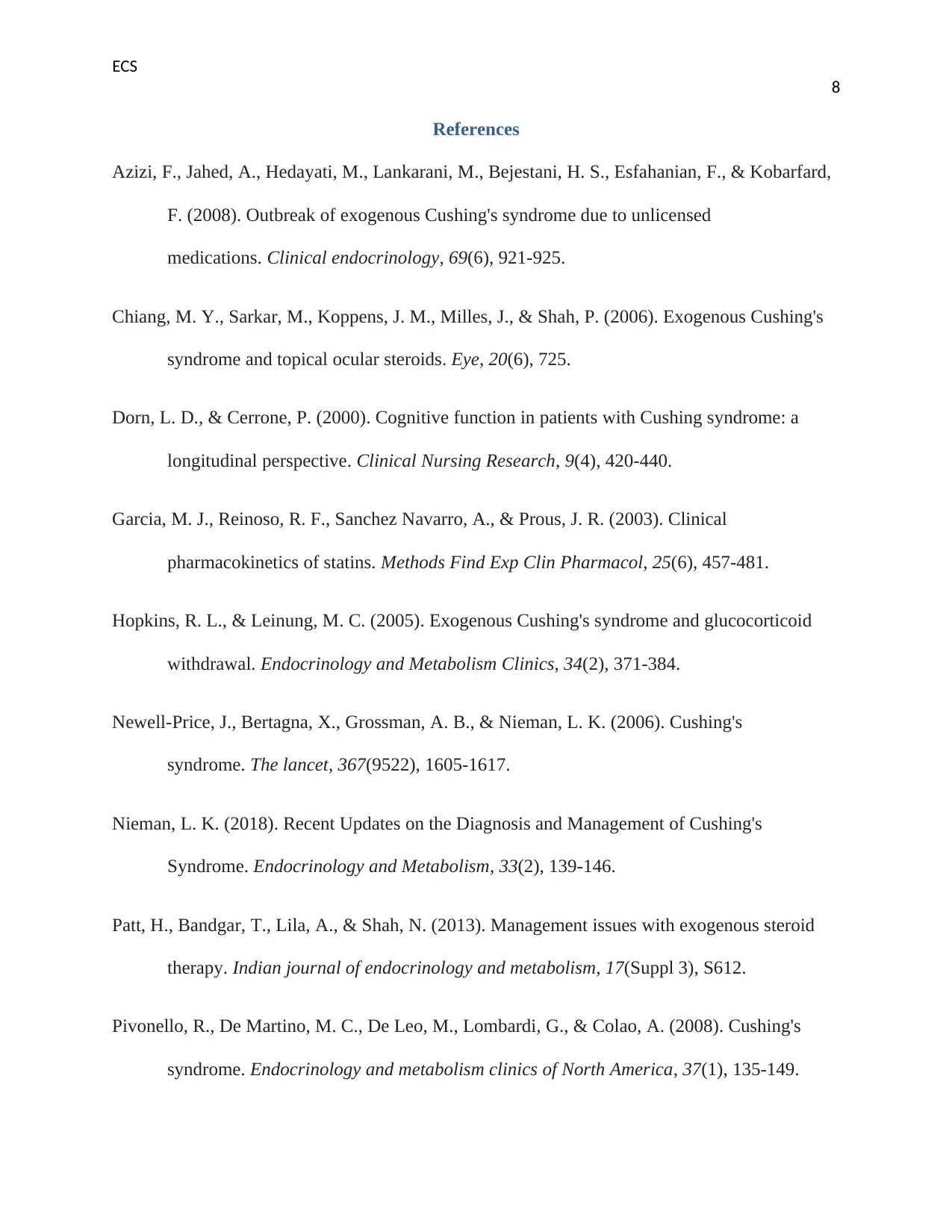
ECS
8
References
Azizi, F., Jahed, A., Hedayati, M., Lankarani, M., Bejestani, H. S., Esfahanian, F., & Kobarfard,
F. (2008). Outbreak of exogenous Cushing's syndrome due to unlicensed
medications. Clinical endocrinology, 69(6), 921-925.
Chiang, M. Y., Sarkar, M., Koppens, J. M., Milles, J., & Shah, P. (2006). Exogenous Cushing's
syndrome and topical ocular steroids. Eye, 20(6), 725.
Dorn, L. D., & Cerrone, P. (2000). Cognitive function in patients with Cushing syndrome: a
longitudinal perspective. Clinical Nursing Research, 9(4), 420-440.
Garcia, M. J., Reinoso, R. F., Sanchez Navarro, A., & Prous, J. R. (2003). Clinical
pharmacokinetics of statins. Methods Find Exp Clin Pharmacol, 25(6), 457-481.
Hopkins, R. L., & Leinung, M. C. (2005). Exogenous Cushing's syndrome and glucocorticoid
withdrawal. Endocrinology and Metabolism Clinics, 34(2), 371-384.
Newell-Price, J., Bertagna, X., Grossman, A. B., & Nieman, L. K. (2006). Cushing's
syndrome. The lancet, 367(9522), 1605-1617.
Nieman, L. K. (2018). Recent Updates on the Diagnosis and Management of Cushing's
Syndrome. Endocrinology and Metabolism, 33(2), 139-146.
Patt, H., Bandgar, T., Lila, A., & Shah, N. (2013). Management issues with exogenous steroid
therapy. Indian journal of endocrinology and metabolism, 17(Suppl 3), S612.
Pivonello, R., De Martino, M. C., De Leo, M., Lombardi, G., & Colao, A. (2008). Cushing's
syndrome. Endocrinology and metabolism clinics of North America, 37(1), 135-149.
8
References
Azizi, F., Jahed, A., Hedayati, M., Lankarani, M., Bejestani, H. S., Esfahanian, F., & Kobarfard,
F. (2008). Outbreak of exogenous Cushing's syndrome due to unlicensed
medications. Clinical endocrinology, 69(6), 921-925.
Chiang, M. Y., Sarkar, M., Koppens, J. M., Milles, J., & Shah, P. (2006). Exogenous Cushing's
syndrome and topical ocular steroids. Eye, 20(6), 725.
Dorn, L. D., & Cerrone, P. (2000). Cognitive function in patients with Cushing syndrome: a
longitudinal perspective. Clinical Nursing Research, 9(4), 420-440.
Garcia, M. J., Reinoso, R. F., Sanchez Navarro, A., & Prous, J. R. (2003). Clinical
pharmacokinetics of statins. Methods Find Exp Clin Pharmacol, 25(6), 457-481.
Hopkins, R. L., & Leinung, M. C. (2005). Exogenous Cushing's syndrome and glucocorticoid
withdrawal. Endocrinology and Metabolism Clinics, 34(2), 371-384.
Newell-Price, J., Bertagna, X., Grossman, A. B., & Nieman, L. K. (2006). Cushing's
syndrome. The lancet, 367(9522), 1605-1617.
Nieman, L. K. (2018). Recent Updates on the Diagnosis and Management of Cushing's
Syndrome. Endocrinology and Metabolism, 33(2), 139-146.
Patt, H., Bandgar, T., Lila, A., & Shah, N. (2013). Management issues with exogenous steroid
therapy. Indian journal of endocrinology and metabolism, 17(Suppl 3), S612.
Pivonello, R., De Martino, M. C., De Leo, M., Lombardi, G., & Colao, A. (2008). Cushing's
syndrome. Endocrinology and metabolism clinics of North America, 37(1), 135-149.
⊘ This is a preview!⊘
Do you want full access?
Subscribe today to unlock all pages.

Trusted by 1+ million students worldwide
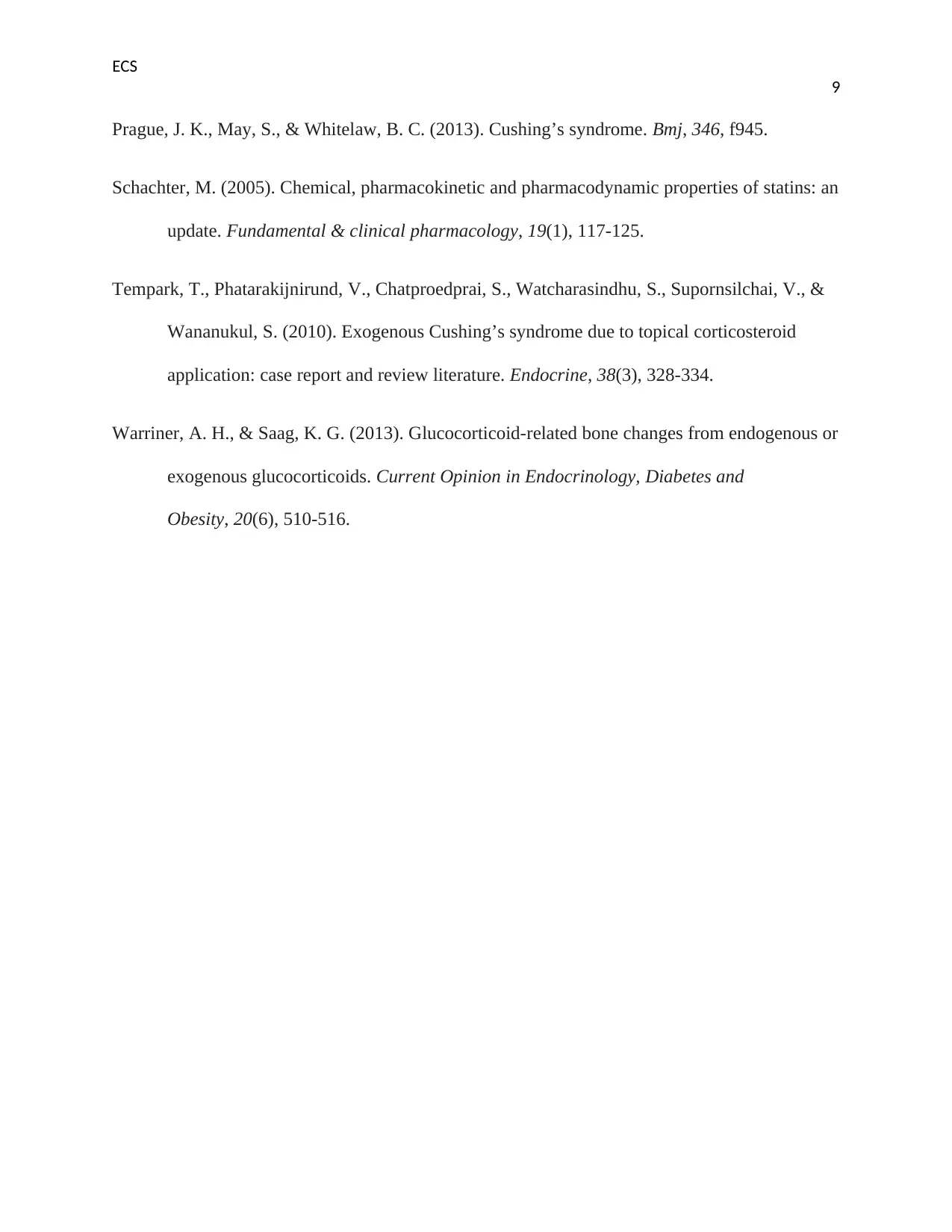
ECS
9
Prague, J. K., May, S., & Whitelaw, B. C. (2013). Cushing’s syndrome. Bmj, 346, f945.
Schachter, M. (2005). Chemical, pharmacokinetic and pharmacodynamic properties of statins: an
update. Fundamental & clinical pharmacology, 19(1), 117-125.
Tempark, T., Phatarakijnirund, V., Chatproedprai, S., Watcharasindhu, S., Supornsilchai, V., &
Wananukul, S. (2010). Exogenous Cushing’s syndrome due to topical corticosteroid
application: case report and review literature. Endocrine, 38(3), 328-334.
Warriner, A. H., & Saag, K. G. (2013). Glucocorticoid-related bone changes from endogenous or
exogenous glucocorticoids. Current Opinion in Endocrinology, Diabetes and
Obesity, 20(6), 510-516.
9
Prague, J. K., May, S., & Whitelaw, B. C. (2013). Cushing’s syndrome. Bmj, 346, f945.
Schachter, M. (2005). Chemical, pharmacokinetic and pharmacodynamic properties of statins: an
update. Fundamental & clinical pharmacology, 19(1), 117-125.
Tempark, T., Phatarakijnirund, V., Chatproedprai, S., Watcharasindhu, S., Supornsilchai, V., &
Wananukul, S. (2010). Exogenous Cushing’s syndrome due to topical corticosteroid
application: case report and review literature. Endocrine, 38(3), 328-334.
Warriner, A. H., & Saag, K. G. (2013). Glucocorticoid-related bone changes from endogenous or
exogenous glucocorticoids. Current Opinion in Endocrinology, Diabetes and
Obesity, 20(6), 510-516.
1 out of 10
Related Documents
Your All-in-One AI-Powered Toolkit for Academic Success.
+13062052269
info@desklib.com
Available 24*7 on WhatsApp / Email
![[object Object]](/_next/static/media/star-bottom.7253800d.svg)
Unlock your academic potential
Copyright © 2020–2025 A2Z Services. All Rights Reserved. Developed and managed by ZUCOL.





